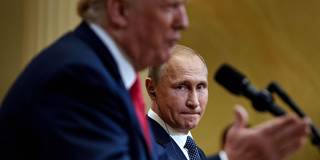Traditionally, one-on-one meetings between government leaders are scheduled only after months, or even years, of careful preparation by lower-ranking officials have narrowed or eliminated disagreements. By turning this sequence around, Donald Trump is fueling, rather than mitigating, global uncertainty.
NEW YORK – US President Donald Trump’s summits with North Korean leader Kim Jong-un in Singapore and Russian President Vladimir Putin in Helsinki are history, as is the G7 summit in Quebec and the NATO summit in Brussels. But already there is talk of another Trump-Putin summit in Washington, DC, sometime later this year. Some 30 years after the end of the Cold War, a four-decade era often punctuated by high-stakes, high-level encounters between American presidents and their Soviet counterparts, summits are back in fashion.
It should be noted that the word “summit” is imprecise. It can be used for high-level meetings of friends as well as foes. Summits can be bilateral or multilateral. And there is no widely accepted rule about when a meeting becomes a summit. More than anything, the term conveys a sense of significance that exceeds that of a run-of-the-mill meeting.
The principal reason summits are back is that they constitute Trump’s favored approach to diplomacy. It is not hard to explain why. Trump views diplomacy in personal terms. He is a great believer in the idea (however debatable) that relationships between individuals can meaningfully shape the relationship between the countries they lead, even transcending sharp policy differences. He is of the world of stagecraft more than statecraft, of pageantry more than policy.

NEW YORK – US President Donald Trump’s summits with North Korean leader Kim Jong-un in Singapore and Russian President Vladimir Putin in Helsinki are history, as is the G7 summit in Quebec and the NATO summit in Brussels. But already there is talk of another Trump-Putin summit in Washington, DC, sometime later this year. Some 30 years after the end of the Cold War, a four-decade era often punctuated by high-stakes, high-level encounters between American presidents and their Soviet counterparts, summits are back in fashion.
It should be noted that the word “summit” is imprecise. It can be used for high-level meetings of friends as well as foes. Summits can be bilateral or multilateral. And there is no widely accepted rule about when a meeting becomes a summit. More than anything, the term conveys a sense of significance that exceeds that of a run-of-the-mill meeting.
The principal reason summits are back is that they constitute Trump’s favored approach to diplomacy. It is not hard to explain why. Trump views diplomacy in personal terms. He is a great believer in the idea (however debatable) that relationships between individuals can meaningfully shape the relationship between the countries they lead, even transcending sharp policy differences. He is of the world of stagecraft more than statecraft, of pageantry more than policy.